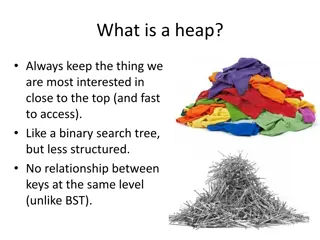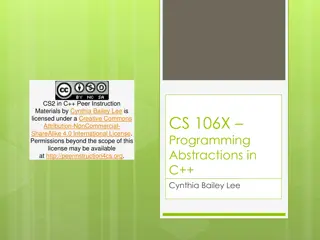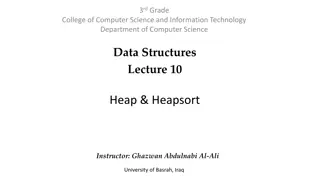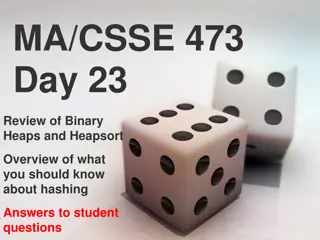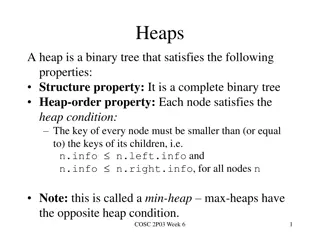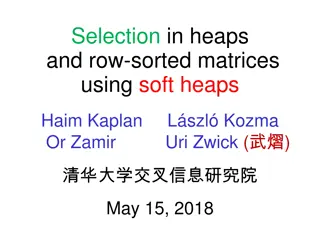Understanding Heaps and Priority Queues in Data Structures
Exploring the concepts of heaps, priority queues, and the Priority Queue ADT in the context of data structures. Topics include the implementation of priority queues, comparing different data structures for efficiency, and the behavior of operations like insert and removeMin.
Download Presentation

Please find below an Image/Link to download the presentation.
The content on the website is provided AS IS for your information and personal use only. It may not be sold, licensed, or shared on other websites without obtaining consent from the author. Download presentation by click this link. If you encounter any issues during the download, it is possible that the publisher has removed the file from their server.
E N D
Presentation Transcript
Lecture 13: Heaps CSE 373 Data Structures and Algorithms CSE 373 19 SP - KASEY CHAMPION 1
Administrivia We ll post midterm review material tonight. In the meantime, go to the bottom of spring s exam page. https://courses.cs.washington.edu/courses/cse373/19sp/exams/ CSE 373 SP 18 - KASEY CHAMPION 2
Heaps CSE 373 SP 18 - KASEY CHAMPION 3
Priority Queue ADT Imagine you re writing a patient management system for an ER. You need to make sure when a doctor becomes available the person who most urgently needs help is seen first. Min Priority Queue ADT state state Set of comparable values - Ordered based on priority behavior behavior insert(value) insert(value) add a new element to the collection Other uses: Operating System Well-designed printers Huffman Codes (in 143) Sorting (in Project 2) Graph algorithms removeMin removeMin() () returns the element with the smallest priority, removes it from the collection peekMin peekMin() () find, but do not remove the element with the smallest priority CSE 332 SU 18 - ROBBIE WEBER 4
Priority Queue ADT Min Priority Queue ADT Max Priority Queue ADT If a Queue is First-In-First-Out (FIFO) Priority Queues are Most-Important-Out-First state state Set of comparable values - Ordered based on priority state state Set of comparable values - Ordered based on priority Items in Priority Queue must be comparable, The data structure will maintain some amount of internal sorting behavior behavior behavior behavior removeMin removeMin() () returns the element with the smallest priority, removes it from the collection peekMin peekMin() () find, but do not remove the element with the smallest priority insert(value) insert(value) add a new element to the collection removeMax removeMax() () returns the element with the largest priority, removes it from the collection peekMax peekMax() () find, but do not remove the element with the largest priority insert(value) insert(value) add a new element to the collection CSE 373 SP 18 - KASEY CHAMPION 5
Implementing Priority Queues: Take I Maybe we already know how to implement a priority queue. How long would insert and removeMin take with these data structures? Implementation Implementation Unsorted Array Insert Insert removeMin removeMin Peek Peek Sorted Array (use circular array ) Linked List (sorted) AVL Tree For Array implementations, assume you do not need to resize. Other than this assumption, do worst case worst case analysis. CSE 332 SU 18 - ROBBIE WEBER 6
Implementing Priority Queues: Take I Maybe we already know how to implement a priority queue. How long would insert and removeMin take with these data structures? Implementation Implementation Unsorted Array Insert Insert removeMin removeMin Peek Peek (1) (?) (?) Sorted Array (use circular array ) (?) (1) (1) Linked List (sorted) (?) (1) (1) AVL Tree (log?) (log?) (log?) For Array implementations, assume you do not need to resize. Other than this assumption, do worst case worst case analysis. CSE 332 SU 18 - ROBBIE WEBER 7
Implementing Priority Queues: Take I Maybe we already know how to implement a priority queue. How long would insert and removeMin take with these data structures? Implementation Implementation Unsorted Array Insert Insert removeMin removeMin Peek Peek (1) (1) (?) ? Sorted Array (use circular array ) (?) (1) (1) Linked List (sorted) (?) (1) (1) AVL Tree (log?) (1) (log?) (log?) Add a class variable to keep track of the min. Update on every insert or remove. CSE 332 SU 18 - ROBBIE WEBER 8
Lets start with an AVL tree There s a technical issue: Priority Queues allow for repeated priorities, AVL trees don t easy to fix - Can add a custom compareTo that arbitrarily breaks ties. - Or just weaken the BST invariant to allow for ties. AVLPriorityQueue<E> state state overallRoot behavior behavior removeMin() traverse through tree all the way to the left, remove node, rebalance if necessary Implementing heaps with AVL trees isn t a crazy idea. We re going to introduce another one, but keep this baseline in your mind. Whatever we come up with, it has to be better than this. peekMin() traverse through tree all the way to the left insert() traverse through tree, insert node in open space, rebalance as necessary CSE 373 19 SP - KASEY CHAMPION 9
Heaps Idea: In a BST, we organized the data to find anything quickly. Now we just want to find the smallest things fast, so let s write a different invariant: Heap invariant Heap invariant Every node is less than or equal to both of its children. In particular, the smallest node is at the root! - Super easy to peek now! Do we need more invariants?
Heaps With the current definition we could still have degenerate trees. The AVL condition was a bit complicated to maintain. - Because we had to make sure when we inserted we could maintain the exact BST structure The heap invariant is looser than the BST invariant. - Which means we can make our structure invariant stricter. Heap structure invariant: Heap structure invariant: A heap is always a complete complete tree. A tree is complete if: - Every row, except possibly the last, is completely full. - The last row is filled from left to right (no gap )
Tree Words Complete every row is completely filled, except possibly the last row, which is filled from left to right. Perfect every row is completely filled 2 4 2 4 2 4 6 4 5 6 4 5 6 4 5 5 5 5 8 8 8 9 9 2 Complete, but not perfect Neither Both Perfect and Complete CSE 332 SU 18 - ROBBIE WEBER 12
Binary Heap One flavor of heap is a binary 1. 1. Binary Tree Binary Tree: every node has at most 2 children 2. 2. Heap Heap: every node is smaller than its child binary heap. 3. 3. Structure: Structure: Each level is complete meaning it has no gaps - Heaps are filled up left to right 1 8 1 2 3 10 9 2 3 22 4 5 7 4 6 5 36 10 9 8 47 CSE 373 SP 18 - KASEY CHAMPION 13
Self Check - Are these valid heaps? 3 Minutes INVALID Binary Heap Invariants: 1. Binary Tree 2. Heap 3. Complete 1 VALID 3 INVALID 4 4 7 7 5 2 5 6 9 6 8 8 7 3 10 9 11 CSE 373 SP 18 - KASEY CHAMPION 14
Implementing peekMin() Runtime: Runtime: ?(1) (1) 2 7 4 10 9 5 8 11 13 CSE 373 SP 18 - KASEY CHAMPION 15
Implementing removeMin() 1.) Return min 2.) replace with last added 13 2 7 7 4 4 10 10 9 9 5 5 8 8 11 11 13 Structure invariant restored, heap invariant broken CSE 373 SP 18 - KASEY CHAMPION 16
Implementing removeMin() - percolateDown 3.) percolateDown() What s the running time? Have to: Find last element Move it to top spot Swap until invariant restored Recursively swap parent with smallest until parent is smaller than both children (or we re at a leaf). smallest child 13 4 7 4 13 5 10 9 5 11 13 8 11 13 Structure invariant restored, heap invariant restored CSE 373 SP 18 - KASEY CHAMPION 17
3 Minutes Practice: removeMin() 5 9 18 9 18 11 10 11 18 13 17 14 20 19 16 15 24 22 18 CSE 373 SP 18 - KASEY CHAMPION 18
Why does percolateDown swap with the smallest child instead of just any child? 13 7 4 10 9 5 8 11 If we swap 13 and 7, the heap invariant isn t restored! 7 is greater than 4 (it s not the smallest child!) so it will violate the invariant.
Implementing insert() Algorithm: -Insert a node to ensure no gaps -Fix heap invariant -percolate UP UP i.e. swap with parent, until your parent is smaller than you (or you re the root). 2 7 4 3 10 9 5 8 3 4 11 3 8 13 CSE 373 19 SP - KASEY CHAMPION 20
3 Minutes Practice: Building a minHeap Construct a Min Binary Heap by inserting the following values in this order: 5, 10, 15, 20, 7, 2 Min Binary Heap Invariants Min Binary Heap Invariants 1. 1. Binary Tree Binary Tree each node has at most 2 children 2. 2. Min Heap Min Heap each node s children are larger than itself 3. 3. Level Complete Level Complete - new nodes are added from left to right completely filling each level before creating a new one Min Priority Queue ADT state state Set of comparable values - Ordered based on priority 5 2 behavior behavior removeMin removeMin() () returns the element with the smallest priority, removes it from the collection peekMin peekMin() () find, but do not remove the element with the smallest priority 15 2 5 10 7 percolateUp percolateUp! ! insert(value) insert(value) add a new element to the collection 2 15 20 7 10 percolateUp percolateUp! ! percolateUp percolateUp! ! CSE 373 SP 18 - KASEY CHAMPION 21
minHeap runtimes removeMin(): - remove root node - Find last node in tree and swap to top level - Percolate down to fix heap invariant insert(): - Insert new node into next available spot - Percolate up to fix heap invariant Finding the last node/next available spot is the hard part. You can do it in (log?) time on complete trees, with some extra class variables But it s NOT fun And there s a much better way! CSE 373 SP 18 - KASEY CHAMPION 22
Implementing Heaps How do we find the minimum node? ???????() = ???[0] A How do we find the last node? ????????() = ???[???? 1] B C How do we find the next open space? ?????????() = ???[????] How do we find a node s left child? E F G D ????? ??? ? = 2? + 1 How do we find a node s right child? J K L H I ??? ?? ??? ? = 2? + 2 How do we find a node s parent? Fill array in level level- -order order from left to right ? 1 2 ?????? ? = 0 0 1 1 2 2 3 3 4 4 5 5 6 6 7 7 8 8 9 9 10 10 11 11 12 12 13 13 A A B B C C D D E E F F G G H H I I J J K K L L CSE 373 19 SP - KASEY CHAMPION 23
Heap Implementation Worst-Case Runtimes Implementation Implementation Array-based heap Insert Insert removeMin removeMin Peek Peek A (log?) (log?) (1) C B We ve matched the asymptotic But we re actually doing better! asymptotic behavior of AVL trees. F D E The constant factors for array accesses are better. The tree can be a constant factor shorter. A heap is MUCH simpler to implement. 0 0 1 1 2 2 3 3 4 4 5 5 6 6 7 7 A A B B C C D D E E F F CSE 373 SP 18 - KASEY CHAMPION 24
More Operations We ll use priority queues for lots of things later in the quarter. Let s add them to our ADT now. Some of these will be asymptotically a heap than an AVL tree! Min Priority Queue ADT state state Set of comparable values - Ordered based on priority asymptotically faster for behavior behavior insert(value) insert(value) add a new element to the collection BuildHeap( BuildHeap(elements ?1, ,??) ) Given ? elements, create a heap containing exactly those ? elements. removeMin removeMin() () returns the element with the smallest priority, removes it from the collection peekMin peekMin() () find, but do not remove the element with the smallest priority
Even More Operations BuildHeap( BuildHeap(elements ?1, ,??) ) Given ? elements, create a heap containing exactly those ? elements. Try 1: Just call insert ? times. Worst case running time? ? calls, each worst case (log?). So it s (?log?) right? That proof isn t valid. There s no guarantee that we re getting the worst case every time! Proof is right if we just want an ?() bound -But it s not clear if it s tight. CSE 332 - SU 18 ROBBIE WEBER 27
BuildHeap Running Time Let s try again for a Theta bound. The problem last time was making sure we always hit the worst case. If we insert the elements in decreasing order we will! -Every node will have to percolate all the way up to the root. So we really have ? (log?) operations. QED. we will! There s still a bug with this proof! CSE 332 - SU 18 ROBBIE WEBER 28
BuildHeap Running Time (again) Let s try once more. Saying the worst case was decreasing order was a good start. What are the actual running times? It s ( ), where is the current current height. -The tree isn t height log? at the beginning. But most nodes are inserted in the last two levels of the tree. -For most nodes, is log? . The number of operations is at least ? 2 (log?) = ?log? . CSE 332 - SU 18 ROBBIE WEBER 29
Where Were We? We were trying to design an algorithm for: BuildHeap( BuildHeap(elements ?1, ,??) ) Given ? elements, create a heap containing exactly those ? elements. Just inserting leads to a (?log?) algorithm in the worst case. Can we do better? CSE 332 - SU 18 ROBBIE WEBER 30
Can We Do Better? What s causing the ?insert strategy to take so long? Most nodes are near the bottom, and they might need to percolate all the way up. What if instead we dumped everything in the array and then tried to percolate things down to fix the invariant? Seems like it might be faster -The bottom two levels of the tree have (?) nodes, the top two have 3 nodes. -Maybe we can make most nodes go a constant distance. CSE 332 - SU 18 ROBBIE WEBER 31
Is It Really Faster? Assume the tree is perfect -the proof for complete trees just gives a different constant factor. percolateDown() doesn t take log ? steps each time! Half the nodes of the tree are leaves -Leaves run percolate down in constant time 1/4 of the nodes have at most 1 level to travel 1/8 the nodes have at most 2 levels to travel etc perfect work(n) ? 2 1 +? 4 2 +? 8 3 + + 1 (log?) CSE 373 SP 18 - KASEY CHAMPION 32
Closed form Floyds buildHeap ?/2 1 +?/4 2 +?/8 3 + +1 (log ?) factor out n 1 21+ 2 22+ 3 23+ + log ? 2log ? Summation! find a pattern -> powers of 2 work(n) ? 1 2+2 4+3 8+ +log ? work(n) ? ? ? ? ? = upper limit should give last term ???? ? ? 2? ?=1 We don t have a summation for this! Let s make it look more like a summation we do know. Infinite geometric series logn? ? 3 4 ? 1 logn 3 ???? ? ? 2? ? = ? 4 ??= ?? 1 < ? < 1 ? ?? 1 ?= ? 2 2? ???? ? ? ?=1 ?=0 ?=0 Floyd s buildHeap runs in O(n) time! ?=1 CSE 373 SP 18 - KASEY CHAMPION 33
Floyds BuildHeap Ok, it s really faster. But can we make it work It s not clear what order to call the percolateDown s in. Should we start at the top or bottom? Will one percolateDown on each element be enough? work? CSE 332 - SU 18 ROBBIE WEBER 34
Floyds buildHeap algorithm Build a tree with the values: 12, 5, 11, 3, 10, 2, 9, 4, 8, 15, 7, 6 12 1. 2. percolateDown(parent) starting at last index Add all values to back of array 5 11 10 2 9 3 15 7 6 4 8 0 0 1 1 2 2 3 3 4 4 5 5 6 6 7 7 8 8 9 9 10 10 11 11 12 12 13 13 15 12 5 11 3 10 2 9 4 8 7 6 CSE 373 SP 18 - KASEY CHAMPION 35
Floyds buildHeap algorithm Build a tree with the values: 12, 5, 11, 3, 10, 2, 9, 4, 8, 15, 7, 6 12 1. 2. percolateDown(parent) starting at last index 1. percolateDown level 4 2. percolateDown level 3 Add all values to back of array 5 11 10 7 7 2 9 3 15 7 10 10 6 4 8 0 0 1 1 2 2 3 3 4 4 5 5 6 6 7 7 8 8 9 9 10 10 11 11 12 12 13 13 12 5 11 3 10 2 9 4 8 7 6 15 CSE 373 SP 18 - KASEY CHAMPION 36
Floyds buildHeap algorithm Build a tree with the values: 12, 5, 11, 3, 10, 2, 9, 4, 8, 15, 7, 6 12 1. 2. percolateDown(parent) starting at last index 1. percolateDown level 4 2. percolateDown level 3 3. percolateDown level 2 Add all values to back of array 5 3 3 11 2 2 2 6 6 10 7 7 9 3 5 5 11 11 keep percolating down like normal here and swap 5 and 4 15 7 10 10 11 11 6 4 8 0 0 1 1 2 2 3 3 4 4 5 5 6 6 7 7 8 8 9 9 10 10 11 11 12 12 13 13 12 5 3 9 4 8 6 11 7 15 2 10 CSE 373 SP 18 - KASEY CHAMPION 37
Floyds buildHeap algorithm Build a tree with the values: 12, 5, 11, 3, 10, 2, 9, 4, 8, 15, 7, 6 12 2 2 1. 2. percolateDown(parent) starting at last index 1. percolateDown level 4 2. percolateDown level 3 3. percolateDown level 2 4. percolateDown level 1 Add all values to back of array 5 3 3 11 2 2 12 12 10 7 7 2 6 6 9 3 4 4 15 7 10 10 6 5 8 11 11 0 0 1 1 2 2 3 3 4 4 5 5 6 6 7 7 8 8 9 9 10 10 11 11 12 12 13 13 12 3 9 5 8 15 2 4 11 6 10 7 CSE 373 SP 18 - KASEY CHAMPION 38
Floyds buildHeap algorithm Build a tree with the values: 12, 5, 11, 3, 10, 2, 9, 4, 8, 15, 7, 6 12 2 2 1. 2. percolateDown(parent) starting at last index 1. percolateDown level 4 2. percolateDown level 3 3. percolateDown level 2 4. percolateDown level 1 Add all values to back of array 5 3 3 11 2 2 6 6 10 7 7 2 6 6 11 11 9 3 4 4 15 7 10 10 6 12 5 8 11 11 12 0 0 1 1 2 2 3 3 4 4 5 5 6 6 7 7 8 8 9 9 10 10 11 11 12 12 13 13 3 11 9 5 8 6 2 15 4 12 10 7 CSE 373 SP 18 - KASEY CHAMPION 39
Even More Operations These operations will be useful in a few weeks IncreaseKey IncreaseKey( (element,priority element,priority) ) Given an element of the heap and a new, larger priority, update that object s priority. DecreaseKey DecreaseKey( (element,priority element,priority) ) Given an element of the heap and a new, smaller priority, update that object s priority. Delete(element) Delete(element) Given an element of the heap, remove that element. Should just be going to the right spot and percolating Going to the right spot is the tricky part. In the programming projects, you ll use a dictionary to find an element quickly. CSE 332 - SU 18 ROBBIE WEBER 40









